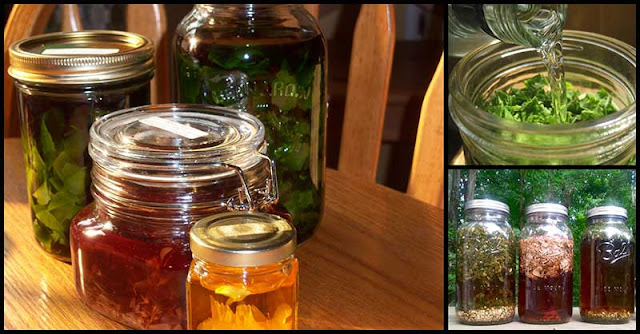An herbal tincture is a concentrated liquid form of herbal medicine which is typically made by soaking herbs in alcohol (or glycerine) for weeks to pull its medicinal properties, thereby making it easy for the body to use. Alcohol is perfect for this since it can extract components (resins and alkaloids) that are not water soluble. After the given period of time, the mixture is strained, separating the concentrated liquid to the herb parts.
Almost any herb can be prepared as a tincture and may include various parts of the plants such as bark, dried leave, fresh leaves, roots, and berries. Usually, tinctures, such as those that promote calmness, are taken orally using a dropper. Meanwhile, some tinctures, such as those for insect stings and sore muscles, can be swabbed on topically.
Here are the common basic steps when creating a tincture:
- Gather the useful parts of the herb(s) – the leaves, roots, berries, bark, or all of these, and remove any unwanted parts.
- Wash thoroughly and chop the herbs.
- Place them into an airtight jar.
- Pour alcohol into the jar and seal it.
- When taking a tincture, simply have ½ to 1 tsp up to three times a day—either straight or mixed into a small amount of water, tea, or juice.
Here’s how to make your own herbal tincture at home:
Note: If you want to make a tincture for children, replace alcohol with apple cider vinegar.
Soothing Chamomile Tincture
For this tincture, you need to get an 8 oz mason jar and fill it with organic chamomile flowers (it should be about 2/3 full). Add 6-7 oz vodka (or any kind of alcohol that’s 80 to 100 proof). Mix them well and then close the jar. Don’t forget to shake well once a day for 2 weeks. After the given period, strain the liquid into a bottle using a cheesecloth (ideally amber-colored to reduce light exposure). You can throw away the flowers. This tincture should be stored in a cool, dark cabinet.
Tummy Tincture
For this tincture, you need to pick up some dried peppermint, some fresh organic ginger root, and some dried fennel seeds.
Together, with chopped ginger root, add fennel seeds and peppermint into a mason jar. Fill the jar with equal amounts of vodka (at least 80 proof) and boiling water. Let the tincture sit for at least two weeks to reach full potency but don’t forget to shake it every day. After the tincture has steeped, strain it using a cheesecloth to get all the liquid out and into your second jar.
Common Tinctures Used in Herbal Medicines
Turmeric Tincture
This spice has a substance known as curcumin which has anti-inflammatory and antioxidant properties. It can help improve memory, relieves pain, fights depression, lowers the risk of heart diseases, protects the body from free radicals, and help prevent cancer.
Echinacea Tincture
Echinacea is high in antioxidants. It can combat infections and viruses, help lower blood sugar levels, fights anxiety, treat skin problems, and may protect against cancer.
Cannabis (CBD) Tincture
This tincture is fast-acting and potent and may help with various health issues such as menstrual pain, anxiety, migraines, seizures, and other types of pain.
Elderberry Tincture
Elderberry fruits are rich in anthocyanins which have antioxidant properties and can help reduce chronic inflammation.
Propolis Tincture
Propolis is a substance produced by bees to build beehives. According to studies, it has positive effects on gastrointestinal disorders, gynecological, oral, and skin disorders, and allergies.









